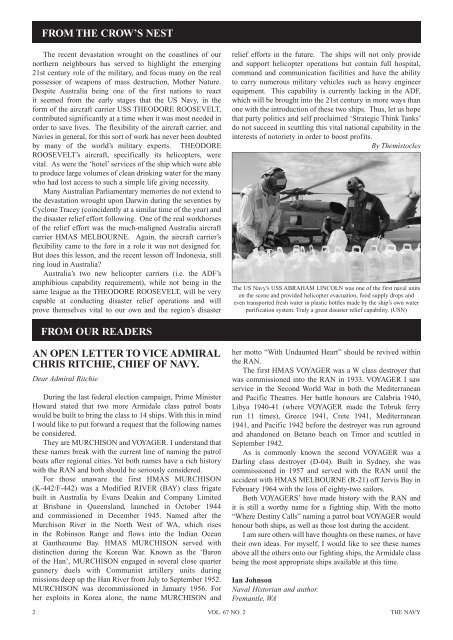The Navy Vol_67_No_2 Apr 2005 - Navy League of Australia
The Navy Vol_67_No_2 Apr 2005 - Navy League of Australia
The Navy Vol_67_No_2 Apr 2005 - Navy League of Australia
You also want an ePaper? Increase the reach of your titles
YUMPU automatically turns print PDFs into web optimized ePapers that Google loves.
FROM THE CROW’S NEST<strong>The</strong> recent devastation wrought on the coastlines <strong>of</strong> ournorthern neighbours has served to highlight the emerging21st century role <strong>of</strong> the military, and focus many on the realpossessor <strong>of</strong> weapons <strong>of</strong> mass destruction, Mother Nature.Despite <strong>Australia</strong> being one <strong>of</strong> the first nations to reactit seemed from the early stages that the US <strong>Navy</strong>, in theform <strong>of</strong> the aircraft carrier USS THEODORE ROOSEVELT,contributed significantly at a time when it was most needed inorder to save lives. <strong>The</strong> flexibility <strong>of</strong> the aircraft carrier, andNavies in general, for this sort <strong>of</strong> work has never been doubtedby many <strong>of</strong> the world’s military experts. THEODOREROOSEVELT’s aircraft, specifically its helicopters, werevital. As were the ‘hotel’ services <strong>of</strong> the ship which were ableto produce large volumes <strong>of</strong> clean drinking water for the manywho had lost access to such a simple life giving necessity.Many <strong>Australia</strong>n Parliamentary memories do not extend tothe devastation wrought upon Darwin during the seventies byCyclone Tracey (coincidently at a similar time <strong>of</strong> the year) andthe disaster relief effort following. One <strong>of</strong> the real workhorses<strong>of</strong> the relief effort was the much-maligned <strong>Australia</strong> aircraftcarrier HMAS MELBOURNE. Again, the aircraft carrier’sflexibility came to the fore in a role it was not designed for.But does this lesson, and the recent lesson <strong>of</strong>f Indonesia, stillring loud in <strong>Australia</strong>?<strong>Australia</strong>’s two new helicopter carriers (i.e. the ADF’samphibious capability requirement), while not being in thesame league as the THEODORE ROOSEVELT, will be verycapable at conducting disaster relief operations and willprove themselves vital to our own and the region’s disasterrelief efforts in the future. <strong>The</strong> ships will not only provideand support helicopter operations but contain full hospital,command and communication facilities and have the abilityto carry numerous military vehicles such as heavy engineerequipment. This capability is currently lacking in the ADF,which will be brought into the 21st century in more ways thanone with the introduction <strong>of</strong> these two ships. Thus, let us hopethat party politics and self proclaimed ‘Strategic Think Tanks’do not succeed in scuttling this vital national capability in theinterests <strong>of</strong> notoriety in order to boost pr<strong>of</strong>its.By <strong>The</strong>mistocles<strong>The</strong> US <strong>Navy</strong>’s USS ABRAHAM LINCOLN was one <strong>of</strong> the first naval unitson the scene and provided helicopter evacuation, food supply drops andeven transported fresh water in plastic bottles made by the ship’s own waterpurification system. Truly a great disaster relief capability. (USN)FROM OUR READERSAN OPEN LETTER TO VICE ADMIRALCHRIS RITCHIE, CHIEF OF NAVY.Dear Admiral RitchieDuring the last federal election campaign, Prime MinisterHoward stated that two more Armidale class patrol boatswould be built to bring the class to 14 ships. With this in mindI would like to put forward a request that the following namesbe considered.<strong>The</strong>y are MURCHISON and VOYAGER. I understand thatthese names break with the current line <strong>of</strong> naming the patrolboats after regional cities. Yet both names have a rich historywith the RAN and both should be seriously considered.For those unaware the first HMAS MURCHISON(K-442/F-442) was a Modified RIVER (BAY) class frigatebuilt in <strong>Australia</strong> by Evans Deakin and Company Limitedat Brisbane in Queensland, launched in October 1944and commissioned in December 1945. Named after theMurchison River in the <strong>No</strong>rth West <strong>of</strong> WA, which risesin the Robinson Range and flows into the Indian Oceanat Gantheaume Bay. HMAS MURCHISON served withdistinction during the Korean War. Known as the ‘Baron<strong>of</strong> the Han’, MURCHISON engaged in several close quartergunnery duels with Communist artillery units duringmissions deep up the Han River from July to September 1952.MURCHISON was decommissioned in January 1956. Forher exploits in Korea alone, the name MURCHISON andher motto “With Undaunted Heart” should be revived withinthe RAN.<strong>The</strong> first HMAS VOYAGER was a W class destroyer thatwas commissioned into the RAN in 1933. VOYAGER I sawservice in the Second World War in both the Mediterraneanand Pacific <strong>The</strong>atres. Her battle honours are Calabria 1940,Libya 1940-41 (where VOYAGER made the Tobruk ferryrun 11 times), Greece 1941, Crete 1941, Mediterranean1941, and Pacific 1942 before the destroyer was run agroundand abandoned on Betano beach on Timor and scuttled inSeptember 1942.As is commonly known the second VOYAGER was aDarling class destroyer (D-04). Built in Sydney, she wascommissioned in 1957 and served with the RAN until theaccident with HMAS MELBOURNE (R-21) <strong>of</strong>f Jervis Bay inFebruary 1964 with the loss <strong>of</strong> eighty-two sailors.Both VOYAGERS’ have made history with the RAN andit is still a worthy name for a fighting ship. With the motto“Where Destiny Calls” naming a patrol boat VOYAGER wouldhonour both ships, as well as those lost during the accident.I am sure others will have thoughts on these names, or havetheir own ideas. For myself, I would like to see these namesabove all the others onto our fighting ships, the Armidale classbeing the most appropriate ships available at this time.Ian JohnsonNaval Historian and author.Fremantle, WA2 VOL. <strong>67</strong> NO. 2 THE NAVY

















